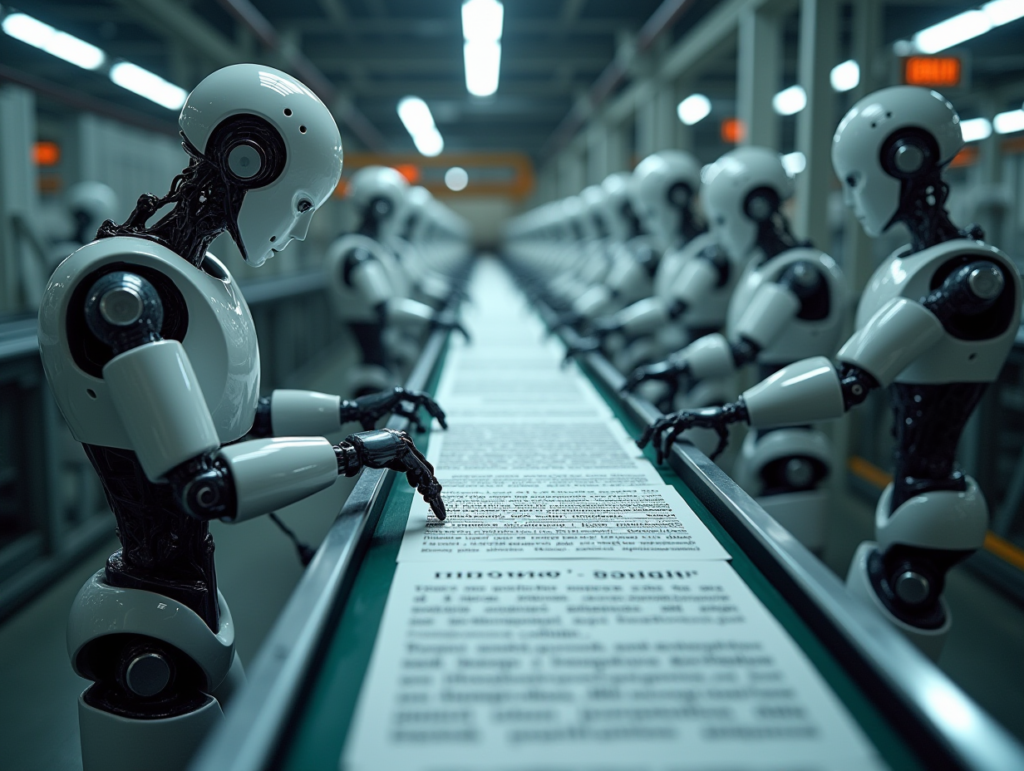How AI-Generated Slop is Slowly Poisoning the Digital World?

Table of Contents
Introduction: The Silent Spread of “AI-Generated Slop”
Have you ever felt like you’re wading through junk when browsing the internet? It’s not just you. The digital world is increasingly cluttered with what’s now being called “AI-generated slop.” Imagine content churned out not to educate, entertain, or enlighten but simply to flood platforms, grab clicks, and boost ad revenue. That’s what we’re dealing with.
AI-generated slop refers to the overwhelming tide of poorly written articles, nonsensical images, and misleading videos that algorithms crank out. On the surface, it might seem like a minor annoyance, but the damage it’s doing to the digital ecosystem is immense. Trust in online content is eroding, creativity is being stifled, and the very fabric of the internet is being poisoned.
Let’s explore what AI-generated slop really is, why it’s spreading, and how it’s slowly dragging the digital world into chaos.
What Exactly is AI-Generated “Slop”?
Let me paint a picture for you: You’re searching for information about a trending topic. You click on a promising link, only to be greeted by a poorly written, repetitive article that provides zero value. Or worse, you stumble upon an AI-generated image that’s bizarrely unsettling—like a warped cat with three eyes. That’s AI-generated slop.
It’s not just about “sloppy” content—it’s about content that’s been churned out without care or purpose. These materials are often created by AI systems trained to mimic patterns in vast datasets, but they lack the contextual understanding or creativity of human authors. Think of it as fast food for the internet—cheap, quick to produce, but ultimately unhealthy.
Examples of AI-Generated Slop
Let’s break down what AI-generated “slop” actually looks like by diving into some common examples. Trust me, once you start spotting them, you’ll realize just how pervasive this stuff has become.

1. Low-Quality Articles Flooding Search Results
Imagine searching for “best ways to boost your immune system” and landing on an article that reads like it was written by a robot—and not a smart one. The article might list generic tips like “eat healthy” or “exercise” but lacks substance, offering no unique insights, credible sources, or actionable advice.
These articles are often produced by AI tools that scrape content from multiple sources, rearrange the text, and spit out something vaguely coherent. But here’s the kicker: they’re optimized with SEO tricks to dominate search rankings, pushing genuinely helpful articles further down. A study by Search Engine Journal found that up to 25% of the top search results in certain niches—like health, finance, and technology—are now AI-generated, and most of this content is riddled with inaccuracies.
2. Clickbait Headlines Paired with Nonsensical Text
Ever clicked on a headline that screamed, “You Won’t Believe What This Celebrity Said About AI!” only to find an incoherent mess of text? That’s AI-generated slop at its finest. Clickbait headlines are crafted to lure readers, but the accompanying content is often meaningless.
This happens because many publishers use AI to churn out dozens of articles a day, hoping the sheer volume will drive traffic. Platforms like Outbrain and Taboola have been criticized for amplifying such low-quality content, contributing to the spread of slop.
3. Bizarre AI-Generated Images and Memes
AI-generated slop isn’t limited to text—it’s also taking over visual content. Remember those viral AI-generated images that went viral, like Pope Francis in a puffer jacket or surreal mashups like “shrimp Jesus”? While some of these are entertaining, many flood social media with poorly rendered, nonsensical images designed to confuse or bait engagement.
A report by Visual Capitalist highlighted that 15% of viral images on platforms like Instagram and Facebook in 2024 were AI-generated. These images often exploit our short attention spans, creating visual clutter while eroding trust in what’s real versus fake.
4. Misleading Product Reviews on E-commerce Sites
Have you ever scrolled through product reviews on Amazon and felt like some of them were written by bots? You’re not wrong. Many e-commerce platforms are plagued by AI-generated reviews that sound generic or overly enthusiastic, like “This product changed my life! Highly recommend to everyone!”
These reviews are created by AI to inflate product ratings, making it harder for consumers to make informed decisions. A 2023 study by Fakespot found that over 30% of reviews for certain product categories were AI-generated, leading to billions of dollars in misinformed purchases.
5. Misinformation Spread via AI-Generated News
Another insidious example of AI-generated slop is fake news. In 2023, NewsGuard flagged over 100 websites that used AI tools to produce misleading or entirely fabricated news stories. These articles often contained snippets of real news mixed with fabricated details, making them seem plausible but ultimately false.
For instance, during the early stages of the COVID-19 pandemic, AI-generated articles falsely claimed that certain foods could “cure” the virus. Such misinformation spread rapidly, causing confusion and, in some cases, public harm.h the muck to find something worthwhile.
The Proliferation of AI-Generated Slop
You might wonder: Why is this low-quality content spreading so quickly? The answer lies in the mechanics of the modern internet.
- The Algorithmic Reward System
Social media platforms and search engines prioritize engagement above all else. If a piece of content garners clicks, likes, or shares, it gets amplified, regardless of its quality. AI-generated content can be churned out at lightning speed, flooding platforms and gaming algorithms for visibility. - Economic Incentives
Websites and platforms generate revenue through ads, and more content means more ad space. Content farms use AI to pump out thousands of articles daily, often sacrificing quality for sheer volume.
For example, NewsGuard found that some of the most-visited sites on the internet, including those dedicated to health and finance, heavily rely on AI to produce click-driven slop. Alarmingly, these sites collectively attract millions of visitors daily, spreading misleading or low-value information.
The Consequences of AI-Generated Slop

1. Erosion of Trust in Online Content
The internet used to be a place where you could find credible, well-sourced information. Now, thanks to AI-generated slop, you’re more likely to encounter half-baked content that either misleads or outright confuses.
Take the medical field, for example. Imagine someone searching for advice on managing diabetes. They land on an AI-generated article that misinterprets basic medical facts, potentially leading to harmful decisions. A study by the Journal of Medical Internet Research found that 40% of AI-generated health articles contained factual inaccuracies, posing real risks to readers.
2. Stifling of Human Creativity
When AI-generated slop dominates online spaces, it pushes genuinely creative voices into the background. Human writers, artists, and creators who put time and thought into their work often find themselves overshadowed by the sheer volume of AI-generated content.
I’ve seen this personally. A friend of mine, a talented freelance writer, shared how her meticulously crafted articles were buried beneath AI-written ones that flooded the search results. These AI articles lacked depth, but they were optimized for SEO, giving them an unfair edge.
3. Information Overload and Decision Fatigue
We’re already living in an age of information overload. Now imagine adding a tidal wave of AI-generated slop into the mix. Users are bombarded with irrelevant, poorly structured content, making it harder to find reliable and valuable information.
According to a Pew Research Center report, 67% of internet users feel overwhelmed by the amount of information online, and AI-generated slop only exacerbates this problem.
My Personal Encounter with AI-Generated Slop
Let me share a personal experience. Last year, while researching a topic on AI ethics, I stumbled upon what seemed like a promising blog. It had a professional layout and even cited a few sources. But as I read further, I realized it was riddled with contradictions, repetitive phrases, and outright falsehoods. It was only later that I discovered the entire article had been AI-generated.
The frustrating part? That article ranked higher than a meticulously researched piece written by a human expert. It was a wake-up call for me, highlighting just how pervasive and damaging AI-generated slop has become.
Why Are Tech Companies Ignoring the Problem?
If AI-generated slop is such a big issue, why aren’t tech giants doing more about it? The truth is, the current digital economy incentivizes quantity over quality.
- Profit Over Responsibility
AI-generated content is cheap and scalable, making it attractive to platforms driven by ad revenue. For companies like Facebook and YouTube, more content equals more user engagement, which translates to higher profits. - Lack of Clear Regulation
The legal and regulatory landscape surrounding AI-generated content is still murky. Without clear guidelines, platforms face little pressure to crack down on low-quality material. - Technological Challenges
Detecting and moderating AI-generated content isn’t easy. While AI can produce slop, developing equally advanced tools to identify and filter it is a complex and ongoing challenge.
Combating AI-Generated Slop: What Can Be Done?
Alright, let’s dive into solutions. Fighting back against AI-generated slop might feel like trying to hold back a tidal wave with a bucket, but it’s not impossible. Here’s what we can—and should—do to reclaim the internet and protect the quality of digital content.
1. Develop Advanced AI Detection Tools
First off, we need better tools to detect slop before it spreads. Right now, many platforms rely on outdated algorithms that can’t distinguish between well-crafted human content and AI-generated junk. Companies like OpenAI and Google have started creating detection tools, but these are still in their infancy.
Imagine an AI system designed not just to flag low-quality content but to assess its coherence, factual accuracy, and relevance. In 2023, a Stanford University study showed that improved AI detection algorithms could reduce the prevalence of AI-generated slop by up to 40% when combined with human moderation. However, these tools need constant updates to stay ahead of evolving AI models.
2. Promote Digital Literacy Among Users
Let’s face it: most people don’t think twice about the source of the content they consume. Educating internet users on how to spot AI-generated slop is crucial. This means teaching people to recognize red flags like overly generic writing, lack of credible sources, or suspicious formatting.
In my experience, even a quick workshop or guide on digital literacy can make a huge difference. For example, a Pew Research Center survey in 2024 found that 65% of users who received basic training in content evaluation were able to identify low-quality, AI-generated articles more accurately than those who hadn’t.
3. Enforce Industry-Wide Regulations
The tech industry is currently like the Wild West—there are few rules governing how AI-generated content is created, shared, or monetized. We need clear, enforceable regulations to hold platforms accountable.
Governments and regulatory bodies should introduce laws requiring transparency about AI-generated content. For instance, every piece of AI-generated material should come with a visible disclaimer, making it clear that it wasn’t created by a human. The European Union is already working on its AI Act, which could serve as a model for other regions. According to MIT Technology Review, such regulations could significantly curb the spread of low-quality content if implemented effectively.
4. Incentivize High-Quality Human Content
One of the best ways to combat slop is to drown it out with authentic, high-quality human content. Platforms like YouTube and Medium could create incentives for creators who produce original, thoughtful work—think higher visibility, better monetization, or even financial rewards for in-depth articles or videos.
This strategy has worked in the past. When Instagram prioritized “meaningful interactions” over engagement bait, it saw a 20% drop in spammy content within six months. Similarly, rewarding human creators could tip the scales back in favor of quality over quantity.
5. Foster Collaboration Between Tech Companies and Fact-Checkers
Fact-checking organizations play a crucial role in verifying the accuracy of online content. By partnering with tech companies, they could help filter out misleading or low-quality AI-generated material. For example, tools like NewsGuard already flag questionable websites, but their reach is limited. If integrated directly into platforms like Facebook or Google, they could have a much broader impact.
The battle against AI-generated slop requires action from all sides—tech companies, regulators, creators, and everyday users. While no single solution will eliminate the problem, a combination of advanced technology, smarter regulations, and a collective commitment to quality can make a real difference.
Conclusion: Reclaiming the Internet from AI-Generated Slop
The rise of AI-generated slop represents one of the greatest challenges to the digital world as we know it. Left unchecked, it threatens to erode trust, stifle creativity, and drown users in a sea of low-value content. But by raising awareness, demanding accountability, and supporting authentic creators, we can begin to reclaim the internet.
Ultimately, the internet should be a place of knowledge, creativity, and genuine human connection. By tackling AI-generated slop head-on, we can preserve what makes the digital world a powerful tool for good. Let’s not settle for anything less.
Let’s work together to ensure that the digital world remains a space where quality, creativity, and integrity thrive. After all, the internet should reflect the best of human innovation, not the careless churn of AI-generated slop.






